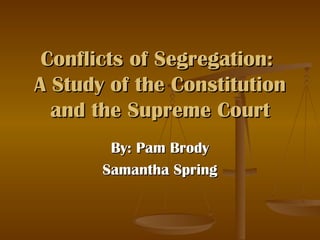
Conflicts Of Segregation 2
- 1. Conflicts of Segregation: A Study of the Constitution and the Supreme Court By: Pam Brody Samantha Spring
- 2. Thesis Question Is there a conflict of segregation between the decisions made by the Supreme Court and the Constitution?
- 3. Thesis Statement The Plessy v. Ferguson(1896) case and the Brown v. Board of Education(1954) case show opposing views that the Supreme Court (using the Constitution) made on segregation.
- 4. Plessy v. Ferguson(1896) In this case, Homer Plessy refused to abide by the Louisiana state law and take an “all whites” train. The Supreme Court ruled that Plessy was guilty due to the fact of “separate but equal.” They ruled that Plessy was getting the same public facility as the whites.
- 5. This case started when African-American third-grader Linda Brown complained to her father Oliver Brown about how far she had to travel to get to school. She went to an African-American school when an all-white school was much closer nearby. Oliver Brown spoke to the local National Association for the Advancement of Colored People (NAACP) and brought the case to the district court. This court ruled in favor of the Board of Education because of the "separate but equal" doctrine that the schools supposedly followed. When this case was brought to the Supreme Court, the Court ruled in favor of Brown because the separated schools were definitely no equal, so they didn't support the 14th Amendment. This decision was the beginning of integration and helped to spark the civil rights movement. Brown v. Board of Education (1954)
- 6. Homer Plessy, a man 7/8 white and 1/8 black, was forced to go on the all-blacks train car by the Louisiana Separate Car Act. One day, he challenged this Act by going on an all-whites car. After going to the district court, Plessy was proven guilty for not following the Louisiana law. In 1896, the Plessy case was appealed to the Supreme Court. Plessy v. Ferguson: the case
- 7. After being brought to the Supreme Court, eight out of nine justices ruled that Plessy was guilty of not following the Louisiana Separate Car Act. They stated that even though whites and blacks couldn’t be in the same car, it was ok for the cars to be segregated because they were the same type of cars following the “separate but equal” clause from the 14 th Amendment. Plessy v. Ferguson: the decision
- 8. Homer Plessy
- 9. When Linda Brown complained to her father about how she had to walk a further distance to her all-blacks school then walk a shorter distance to an all-whites school, her father, Oliver Brown, made sure that she would get her rights to walk a shorter distance. The NAACP thought their best lawyer, Thurgood Marshall, could have their name be shown in the case of Brown v. Board of Education. The NAACP was looking for a case that would spread their beliefs of integrating schools, and this case was the one. When brought to the Topeka, Kansas district court, they ruled in favor of the Board of Education due to the “separate but equal” clause made in the Plessy case. After this decision, The NAACP would not stand for it, and made itself known to the Supreme Court. Brown v. Board of Education: the case
- 10. School Linda Brown attended
- 12. Linda Brown Oliver Brown
- 14. Supreme Court in 1896
- 16. Supreme Court in 1954